Back to page 1
The Design
HOK Sport, which has since changed its name to Populous, designed two of this year’s new spring-training parks. Unlike their project in Port Charlotte, FL, which was rebuilt on the skeleton of a previous stadium, Goodyear’s site allowed HOK to create a footprint for the park from scratch. In endeavoring to create a ballpark “like no other,” the goal was to move the main structures in the facility into the infield area. This creates a relatively long walkway from the home-plate gate itself to the main concourse (below left). Along this walkway is the full length of the retail store, a guest-services booth, and various doors to the ticket office and to the elevators for the suites.
That means that once you leave the covered concourse in the infield area, you step out into wide open spaces, particularly on the first-base side. In other words, if you’re walking from behind home plate toward the right-field foul pole, you are struck by how abruptly you leave the cave-like surroundings of a wall to your right, the ceiling over your head and the seating bowl to your left. It is then open on both sides of you, which feels a little odd in a ballpark. You’re used to having concession stands or buildings with restrooms on the side of the concourse opposite the seats. That’s not the case here.
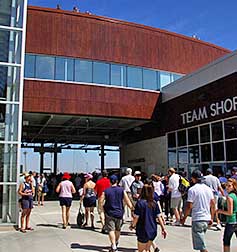 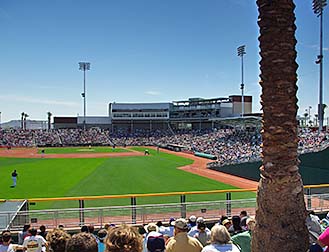 |
It is a liberating feeling, to say the least — quite unlike the incredible number of structures that surround you at almost all times at Glendale’s new park as you walk around its 360-degree concourse.
Which brings me to the single biggest difference in the approach taken with Goodyear’s park versus Glendale’s. In the latter, the sheer enormity of the place almost overwhelms you as you walk around it, as you notice the buildings on all sides, especially the mammoth clubhouse buildings beyond right field and left. And when you realize that you can cram 13,000 fans into the place, you think to yourself, “Is all of this necessary just for spring-training games?”
I think there are three reasons why there is such a huge difference in the feeling of “size” from Glendale to Goodyear. First, the clubhouses for the two major-league clubs in Goodyear are within the practice fields to the south of the ballpark, not beside the park like in Glendale. Second, the commercial development that is planned in Glendale isn’t meant to be incorporated into the footprint of the ballpark itself. No, it is meant to be on the periphery of the baseball complex. In Goodyear, though, you will notice commercial buildings right next to the concourses in the conceptual drawings of the master plan for development. And construction for those buildings hasn’t even begun … so you have nice green grass there now.
And the third, and perhaps most important, reason for the arrangement of structures in Goodyear is fairly simple. The architects and city wanted an intimate feel to the place. They achieved that extremely well. Even though there were over 10,000 fans at the game I attended, you still felt as though it was an intimate gathering.
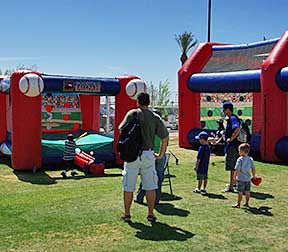 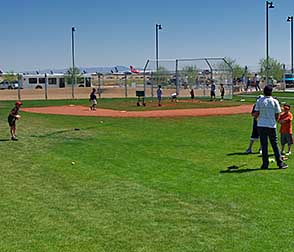 |
These “wide open” areas of the park — at least until commercial buildings are constructed — give Goodyear Ballpark another huge advantage over Glendale: places where kids can play. While Camelback Ranch in Glendale has almost every feature a park could conceivable have, it inexplicably lacks play areas for kids. Goodyear gets an A+ in this facet, as there are inflatables in the grassy area behind first base (above left), as well as a full small-scale baseball field (above right). Bravo!
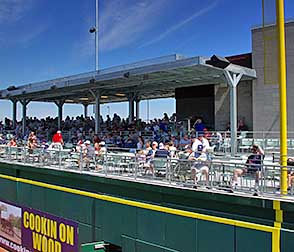 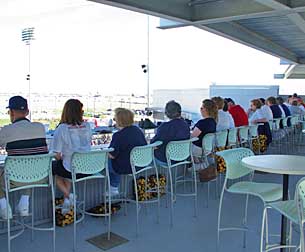 |
There is a structure that is separate from the clustering behind home plate. That’s the right-field pavilion (above left), which can be rented out by groups or where individual ticket buyers can pay $30 to watch the game from a really great vantage point and eat their fill at the buffet. There is also a “terrace” (above right) high above the concourse behind home that provides you with a birds-eye view of the action and access to the buffet there.
 |
Interestingly, the terrace isn’t centered behind home plate — and neither is the press box. If you look closely, you’ll see that the structure above the concourse is unlike almost any other springtime or minor-league ballpark. I’ve remarked often that when I take a photo from center field of the main seating bowl at most non-Major League ballparks, it’s pretty hard to tell one from another. Most have an upper level with the press area centered between a number of suites on either side.
Not here. The pressbox is on the same level as the suites, but it is entirely on the first-base side, while the well-heeled suite-holders are on the third-base side. The terrace is directly above the suites. Frankly, I like this asymmetrical look!
The Essentials
Goodyear’s new park is aesthetically pleasing, well designed and is clearly the result of great planning … but how much of that do you care about if you’re a fan attending a game here? While it’s always nicer to watch a game in a nice park, most of that planning (but not all) results in a great game-day experience.
As I mentioned, the planning that went into traffic flow and parking was very good indeed. Parking costs $5, the same as at Glendale — of course, it’s free in Surprise and Peoria, the other two two-team complexes in the West Valley.
I found the ticket prices to be reasonable — certainly more so than at Glendale. The most expensive ticket is $35, which gives you a wonderful view of the field — and all you can eat from a buffet — in the terrace area high above the backstop. For $30 you can sit in the right-field pavilion, which also features a buffet. Regular box seats cost $23, while bigger spenders could choose specially shaded Club seats with more legroom on the third-base side or “Premium” seats right next to the field for $27. Farther down the foul lines, reserved seats are $18 and $12. If you want to sit on the grass berms in the outfield, it will set you back $8.
I really liked the Club seats. One of the “nice touches” in this park is the huge covering over this area (below left). And since there’s a kiosk selling beer under this big canopy (right), you never have to venture out into the desert sun to quench your thirst!
The Indians ran several promotions this spring that saved fans a few dollars on the price of admission. When ticket sales didn’t fly through the ceiling, some tickets for weekday games were offered at half price, as was a “family fun pack” for $48 that provided four general-admission tickets, with hot dogs, drinks and chips for the family. As far as I could tell, these special promotions were only available at the box office, not online.
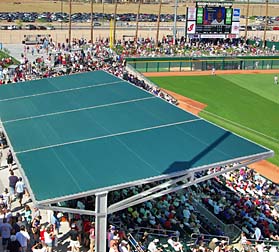 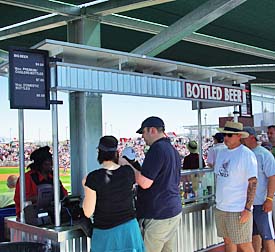 |
In the photo below, note the way the “structures” of the ballpark are restricted to the infield area. This (and the height of the structures) creates two interesting effects, one a little negative and the other overwhelmingly positive. First, airflow through the main seating bowl behind home isn’t optimal, unlike in Glendale where the upper level is elevated above the concourse by steel supports, which allows the air to flow freely. However, the shade provided to the seats behind home by the tall, clustered buildings in Goodyear is very welcomed — and shade is something in short supply in Glendale.
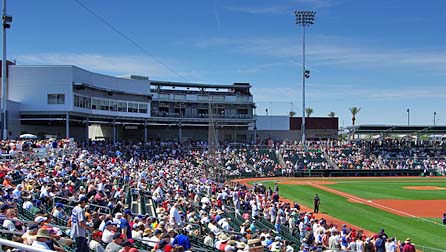 |
I was very impressed with the main souvenir shop, located near the entry gate behind home plate. It’s a little unusual that a store isn’t on the concourse ringing the field, but there is some thought that once all of the other development adjoining the park is completed, they might want to open that store year-round. To make that feasible, it would have to have an entrance on the exterior of the ballpark.
The store is certainly large enough (below left), and I was really, really impressed by the assortment of apparel. This was especially true of clothing for kids, which far outdistanced the offerings for the younger set in Glendale. Further, the prices in Goodyear were reasonable, as adult T-shirts were typically $22 and lapel pins only $6.
Of course, starting in 2010, they will need to find room for two teams’ souvenirs, which might impact the assortment of merchandise.
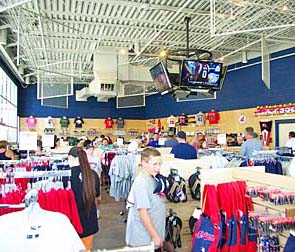 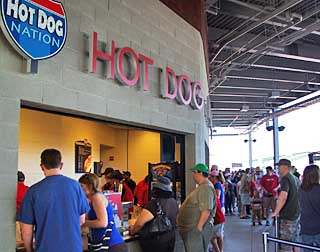 |
Aside from the buffets, the food offerings were more than adequate. It seemed to me that the most popular food stand was Tamales Mexican Grill behind third base. Here you’ll find burritos ($7), tacos ($7) and, of course, tamales ($6.50). They also served standard fare here, like “jumbo” hot dogs ($4) and hamburgers ($5.50).
You’ll find free-standing food kiosks all around the concourse, including ones for BBQ (the sandwich is $7), grilled dogs (bratwurst and Italian sausages were $6.50), cheesesteaks ($8) and Italian Ice ($4). These are very nicely spaced all around the ballpark, but oddly, the seats around the infield were the most under-serviced for food choices. That’s because there’s only one concession stand along the main concourse directly behind homeplate, and the lines were fairly long here all through the game.
This stand, called Hot Dog Nation (above right), also happened to be my favorite at the park. Here you’ll hot dogs served six different ways — plain and in the style of five different U.S. locales: New York; Chicago; Arizona; Cincinnati (with chili, of course) and Cleveland. The last one in this list features BBQ sauce, bacon, shredded cheese and onions — all for only $5.
There’s only one scoreboard, but it does feature a nice color video screen over top of the standard ballgame info.
Summary
From cotton fields to ball fields, this plot of land near Goodyear, Arizona’s airport has sprung to life.
To be fair, when all of the development is complete, this park might not have the same “feel” at all. Without a doubt, it will probably lose the “wide open” feel outside of the concourses … but considering how beautifully phase one (the Indians practice fields and the ballpark itself) was planned, I have every confidence that it will turn out extremely well.
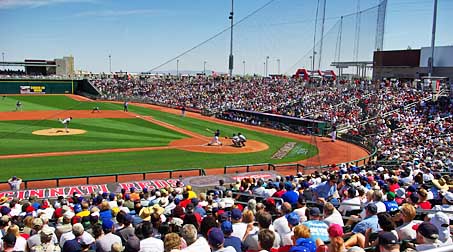 |
You know, I met an interesting group of people during my visit to Goodyear’s park. This tour group, organized by Action Travel of Solon, Ohio, rented out the terrace area for several games in a row. The owner of the travel firm, Arlene Goldberg, told me that for the past thirteen Marches, she led a group of Indians fans to Winter Haven, the Tribe’s previous spring-training home.
“Winter Haven was a special place,” she told me, “but it was nothing compared to this. Here, everything is so beautiful and new. The people here are every bit as nice as the ones in Florida, and here you don’t have the constant rain delays and rainouts. No, there’s no place like this back there. We wouldn’t ever want to go back to Winter Haven.”
Neither would the Indians, because back in the Sunshine State, you won’t find a ballpark “like no other.”